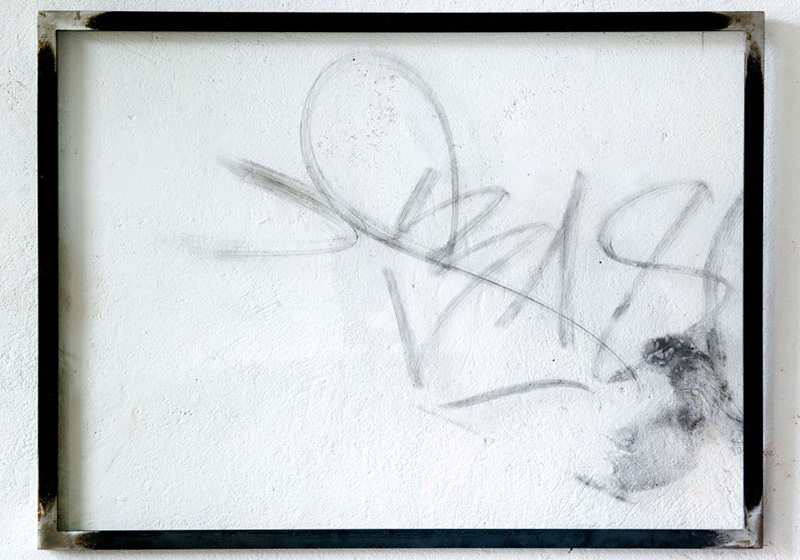Tunisia/Russia
Leigh Peterson
The works of Nadia Kaabi-Linke are embedded in urban contexts and are concerned with memory and place, brevity and movement. Kaabi-Linke grew up in Tunis, Kiev, and Dubai, studied in Paris at the Sorbonne, and currently lives in Berlin. Consequently, migration across cultures is part of her history and identity. Her work appropriates the varied characteristics of place and material, which she considers to have “a sort of silent memory.” 1 Each work evokes a specific place and time through its production and preservation of physical historical traces.

Forensic fingerprint powder, human sweat and sebum, anti-graffiti film, on plexiglass
21.4 x 28.9 in (54.5 x 73.5cm)
Private Collection
In Study (3) for Berlin à fleur de peau, Kaabi- Linke captures graffiti and other markings found on bus shelters, subway stations, and alternative means of public transport in Berlin. To preserve these traces, she uses forensic techniques and materials combined with glaziery methods. First she sprinkles the desired markings with velvet black powder, an adhesive substance frequently used by police at crime scenes to make prints visible. Then, she covers the powder prints with a protective liner, and transfers these traces to a small wet pane of plexiglass, creating spectral images of scratches, dents, and traces of sebum, fat, skin, and sweat. Through the accumulation of all of these traces, the glass becomes a “material memory” of the activities of numerous, anonymous individuals and the events of everyday life. 2
Kaabi-Linke is fascinated by the way (un) intentional human gestures overlap many times within a pane of plexiglass. In this pictorial representation, the smudgy representation of a handprint is as noticeable as the deliberate piece of graffiti behind it. By drawing equal attention to both marks, the artist seems to close the gap between the innocence of unconscious skin contact and deliberate acts of vandalism. 3 It becomes unclear to the viewer: is the handprint that at first glance seemed that of a thoughtless, passive passenger actually the mark of a criminal agent?
- Falko Schmieder, “Nadia Kaabi-Linke: On the Track of History,” Nka: Journal of Contemporary African Art, 32, Spring, 2013, 132. ↑
- http://www.nadiakaabilinke.com/work/2010/berlin/berlin.html# ↑
- Jamila Adeli and Susan Kamel, “Art as Evidence: Jamila Adeli and Susan Kamel in Conversation with Nadia Kaabi-Linke,” Nadia Kaabi-Linke: Tatort, Kerber Edition Young Art, Berlin, 2010, 7. ↑
